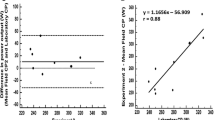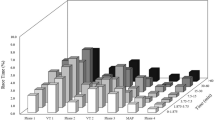Abstract
Performance tests are an integral component of assessment for competitive cyclists in practical and research settings. Cycle ergometry is the basis of most of these tests. Most cycle ergometers are stationary devices that measure power while a cyclist pedals against sliding friction (e.g. Monark), electromagnetic braking (e.g. Lode), or air resistance (e.g. Kingcycle). Mobile ergometers (e.g. SRM cranks) allow measurement of power through the drive train of the cyclist’s own bike in real or simulated competitions on the road, in a velodrome or in the laboratory. The manufacturers’ calibration of all ergometers is questionable; dynamic recalibration with a special rig is therefore desirable for comparison of cyclists tested on different ergometers.
For monitoring changes in performance of a cyclist, an ergometer should introduce negligible random error (variation) in its measurements; in this respect, SRM cranks appear to be the best ergometer, but more comparison studies of ergometers are needed. Random error in the cyclist’s performance should also be minimised by choice of an appropriate type of test. Tests based on physiological measures (e.g. maximum oxygen uptake, anaerobic threshold) and tests requiring self-selection of pace (e.g. constant-duration and constant-distance tests) usually produce random error of at least ~2 to 3%in the measure of power output. Random error as low as ~1% is possible for measures of power in ’all-out’ sprints, incremental tests, constant-power tests to exhaustion and probably also time trials in an indoor velodrome. Measures with such low error might be suitable for tracking the small changes in competitive performance that matter to elite cyclists.

Similar content being viewed by others
References
Hopkins WG, Schabort EJ, Hawley JA. Reliability of power in physical performance tests. Sports Med 2001; 31 (3): 211–234
Clark JH, Greenleaf JE. Electronic bicycle ergometer: a simple calibration procedure. J Appl Physiol 1971; 30: 440–2
Cumming GR, Alexander WD. The calibration of bicycle ergometers. Can J Appl Physiol Pharmacol 1968; 46: 917–9
Russell JC, Dale JB. Dynamic torquemeter calibration of bicycle ergometers. J Appl Physiol 1986; 61: 1217–20
Wilmore JH, Constable SH, Stanforth PR, et al. Mechanical and physiological calibration of four cycle ergometers. Med Sci Sports Exerc 1982; 14: 322–5
Woods GF, Day L, Withers RT, et al. The dynamic calibration of cycle ergometers. Int J Sports Med 1994; 15: 168–71
Hopkins WG. Measures of reliability in sports medicine and science [letter]. Sports Med 2000; 30: 375–81
Maxwell BF, Withers RT, Ilsley AH, et al. Dynamic calibration of mechanically, air- and electromagnetically braked cycle ergometers. Eur J Appl Physiol 1998; 78: 346–52
Martin JC, Milliken DL, Cobb JE, et al. Validation of a mathematical model for road cycling power. J Appl Biomech 1998; 14: 276–91
Finn JP, Maxwell BF, Withers RT. Air-braked cycle ergometers: validity of the correction factor for barometric pressure. Int J Sports Med 2000; 21: 488–91
Balmer J, Davison RCR, Bird SR. Peak power predicts performance power during an outdoor 16.1-km cycling time trial. Med Sci Sports Exerc 2000; 32: 1485–90
Palmer GS, Dennis SC, Noakes TD, et al. Assessment of the reproducibility of performance testing on an air-braked cycle ergometer. Int J Sports Med 1996; 17: 293–8
Kingcycle. Kingcycle tester/trainer [online]. Available from: URL: http://www.portaprompt.co.uk/king [Accessed 2001 Jan 30]
Lawton EW, Martin DT, Lee H. Validation of SRM power cranks using dynamic calibration. Fifth IOC World Congress; 1999 Oct 31-Nov 5; Sydney. Sydney: International Olympic Committee, 1999: 199
Jones SM, Passfield L. The dynamic calibration of bicycle power measuring cranks. In: Haake SJ, editor. The engineering of sport. Oxford: Blackwell, 1998: 265–74
Hoogeveen AR, Schep G, Hoogsteen J. The ventilatory threshold, heart rate, and endurance performance relationships in elite cyclists. Int J Sports Med 1999; 20: 114–7
Hopkins SR, McKenzie DC. Laboratory assessment of endurance performance in cyclists. Can J Appl Physiol 1994; 19: 266–74
Miller FR, Manfredi TG. Physiological and anthropometrical predictors of 15-kilometer time trial cycling performance time. Res Q Exerc Sport 1987; 58: 250–4
Coyle EF, Feltner ME, Kautz SA, et al. Physiological and biomechanical factors associated with elite endurance cycling performance. Med Sci Sports Exerc 1991; 23: 93–107
Hawley JA, Noakes TD. Peak power output predicts maximal oxygen uptake and performance time in trained cyclists. Eur J Appl Physiol 1992; 65: 79–83
Hopkins WG, Hawley JA, Burke LM. Design and analysis of research on sport performance enhancement. Med Sci Sports Exerc 1999; 31: 472–85
Author information
Authors and Affiliations
Corresponding author
Rights and permissions
About this article
Cite this article
Paton, C.D., Hopkins, W.G. Tests of Cycling Performance. Sports Med 31, 489–496 (2001). https://doi.org/10.2165/00007256-200131070-00004
Published:
Issue Date:
DOI: https://doi.org/10.2165/00007256-200131070-00004




